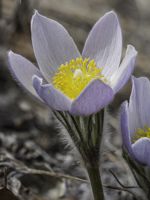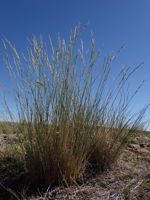Mon-Fri 9am - 5pm Mountain time
Bluebunch Wheatgrass vs Prairie Crocus
Pulsatilla nuttalliana (Anemone patens)
Pseudoroegneria spicata (Agropyron spicatum)
NOT AVAILABLE THIS SEASON - MIGHT RETURN
CUSTOM GROW
Prairie Crocus is a native perennial wildflower that is often considered one of the first signs of spring. The flowers can range from purple, pale blue, to white and often appear before the snow has fully melted. It can bloom a month earlier than other spring flowers, providing an early source of pollen for a variety of pollinators.
The plant is covered in woolly white hairs, including the finely divided leaves, giving them a silvery appearance. Prairie Crocus leaves do not fully emerge until after it has bloomed. The spent blooms transform into fluffy, feathery seed heads. During the hot summer months, the Prairie Crocus goes dormant and will repeat its life cycle the following spring.
The Prairie Crocus is Manitoba’s provincial flower.
Bluebunch Wheatgrass is a native perennial bunchgrass common across prairies, foothills, and open woodlands. Longer-lived than many other grass species, it develops deep, fibrous roots that stabilize soils and make it drought-tolerant once established. It is a cool-season grass, growing most actively in spring and fall and slowing during the heat of summer.
This hardy grass provides excellent forage for deer, elk, and bighorn sheep, and is especially palatable to livestock. Its seeds feed birds and small mammals, while its bunching growth offers protective cover for ground-nesting birds such as sparrows and sage-grouse, as well as shelter for small mammals. Bluebunch Wheatgrass is well-suited to rangeland & prairie restoration, naturalization, and erosion control projects.
Prairie Crocus Quick Facts
Bluebunch Wheatgrass Quick Facts
Toxicity: all parts toxic if eaten, sap can irritate skin

